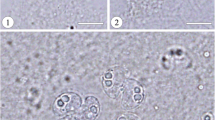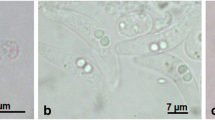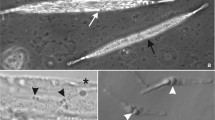Abstract
During a survey of myxosporean parasites of marine fishes from the Arabian Gulf in Saudi Arabia, spores of Ceratomyxa husseini n. sp. were found in the gall-bladders of 50 out of 148 specimens (33.8%) of the yellowfin hind Cephalopholis hemistiktos (Rüppell) (Perciformes: Serranidae). The rates of infection showed a seasonal fluctuation, with the highest prevalence in winter and the lowest in autumn. The mature spores appeared arched in frontal view with rounded valve ends and a slightly discriminated curved suture line and measured 8–9 × 14–18 (9 × 16) μm. The two polar capsules were spherical and equal in size, 4–5 (4.5) μm in diameter. The polar filament showed four turns obliquely to the longitudinal axis of the capsules and the sporoplasm filled half of the entire spore cavity. Partial sequences of the small subunit rRNA gene of C. husseini n. sp. showed percentage of identity with other species of Ceratomyxa ranging between 79.8 and 92.7%. The morphometric and molecular data, in association, confirmed that the present new species differs from all other Ceratomyxa spp. reported to date.



Similar content being viewed by others
References
Abied, A. M., Abu El Regal, M. A., & Khalil, A. H. (2014). RAPD - PCR analysis of four coral reef fish species, genus Cephalopholis (Family: serranidae) in the Red sea. Egyptian Journal of Aquatic Biology and Fisheries, 18, 125–141.
Alama-Bermejo, G., Raga, J. A., & Holzer, A. S. (2011). Host-parasite relationship of Ceratomyxa puntazzi n. sp. (Myxozoa: Myxosporea) and sharpsnout seabream Diplodus puntazzo (Walbaum, 1792) from the Mediterranean with first data on ceratomyxid host specificity in sparids. Veterinary Parasitology, 182, 181–192.
Al-Qahtani, H. A., Mansour, L., Al-Quraishy, S., & Abdel-Baki, A. S. (2015). Morphology, phylogeny and seasonal prevalence of Ceratomyxa arabica n. sp. (Myxozoa: Myxosporea) infecting the gallbladder of Acanthopagrus bifasciatus (Pisces: Sparidae) from the Arabian Gulf, Saudi Arabia. Parasitolgy Research, 114, 465–671.
Altschul, S. F., Madden, T. L., Schäffer, A. A., Zhang, J., Zhang, Z., Miller, W., & Lipman, D. J. (1997). Gapped BLAST and PSI-BLAST: a new generation of protein database search programs. Nucleic Acids Research, 25, 3389–3402.
Azevedo, C., Rocha, S., Casal, G., São Clemente, S. C., Matos, P., Al-Quraishy, S., & Matos, E. (2013). Ultrastructural description of Ceratomyxa microlepis sp. nov. (phylum Myxozoa): a parasite infecting the gall bladder of Hemiodus microlepis, a freshwater teleost from the Amazon River. Memórias do Instituto Oswaldo Cruz, 108, 150–154.
Eiras, J. C. (2006). Synopsis of the species of Ceratomyxa Thélohan, 1892 (Myxozoa: Myxosporea: Ceratomyxidae). Systematic Parasitology, 65, 49–71.
FAO (2002). The state of world fisheries and aquaculture. Rome, Italy: FAO.
Fiala, I. (2006). The phylogeny of Myxosporea (Myxozoa) based on small subunit ribosomal RNA gene analysis. International Journal for Parasitology, 36, 1521–1534.
Foott, J. S., & Hedrick, R. P. (1987). Seasonal occurrence of the infectious stage of proliferative kidney disease (PKD) and resistance of rainbow trout, Salmo gairdneri Richardson, to reinfection. Journal of Fish Biology, 30, 477–483.
Freeman, M. A., Yokoyama, H., & Ogawa, K. (2008). Description and phylogeny of Ceratomyxa anko sp. n. and Zschokkella lophii sp. n. from the Japanese anglerfish, Lophius litulon (Jordan). Journal of Fish Diseases, 31, 921–930.
Gunter, N. L., & Adlard, R. D. (2008). Bivalvulidan (Myxozoa: Myxosporea) parasites of damselfishes with description of twelve novel species from Australia’s Great Barrier Reef. Parasitology, 135, 1165–1178.
Gunter, N., & Adlard, R. (2009). Seven new species of Ceratomyxa from the gall bladders of serranids from the Great Barrier Reef, Australia. Systematic Parasitology, 73, 1–11.
Gunter, N. L., Whipps, C. M., & Adlard, R. D. (2009). Ceratomyxa (Myxozoa: Bivalvulida): robust taxon or genus of convenience? International Journal for Parasitology, 39, 1395–1405.
Gunter, N. L., Burger, M. A. A., & Adlard, R. D. (2010). Morphometric and molecular characterisation of four new Ceratomyxa species (Myxosporea: Bivalvulida: Ceratomyxidae) from fishes off Lizard Island, Australia. Folia Parasitologica, 57, 1–10.
Haaparanta, A., Valtonen, E. T., & Hoffrnann, R. W. (1994). Pathogenicity and seasonal occurrence of Henneguya creplini (Protozoa, Myxosporea) on the gills of perch Perca fluviatilis in central Finland. Diseases of Aquatic Organisms, 20, 15–22.
Heiniger, H., & Adlard, R. D. (2013). Molecular identification of cryptic species of Ceratomyxa Thélohan, 1892 (Myxosporea: Bivalvulida) including the description of eight novel species from apogonid fishes (Perciformes: Apogonidae) from Australian waters. Acta Parasitologica, 58, 342–360.
Heiniger, H., Gunter, N. L., & Adlard, R. D. (2008). Relationships between four novel ceratomyxid parasites from the gall bladders of labrid fishes from Heron Island, Australia. Parasitology International, 57, 158–165.
Kent, M. L., Andree, K. B., Bartholomew, J. L., El-Matbouli, M., Desser, S. S. et al. (2001). Recent advances in our knowledge of the Myxozoa. Journal of Eukaryotic Microbiology, 48, 395–413.
Kimura, M. (1980). A simple method for estimating evolutionary rate of base substitutions through comparative studies of nucleotide sequences. Journal of Molecular Evolution, 16, 111–120.
Køie, M., Karlsbakk, E., & Nylund, A. (2008). The marine herring myxozoan Ceratomyxa auerbachi (Myxozoa: Ceratomyxidae) uses Chone infundibuliformis (Annelida: Polychaeta: Sabellidae) as invertebrate host. Folia Parasitologica, 55, 100–104.
Larkin, M. A., Blackshields, G., Brown, N. P., Chenna, R., McGettigan, P. A. et al. (2007). Clustal W and Clustal X version 2.0. Bioinformatics, 23, 2947–2948.
Lom, J., & Arthur, J. R. (1989). A guideline for the preparation of species descriptions in Myxosporea. Journal of Fish Diseases, 12, 151–156.
Lom, J., & Dykova, I. (2006). Myxozoan genera: definition and notes on taxonomy, life-cycle terminology and pathogenic species. Folia Parasitologica, 53, 1–36.
Mansour, L., Al-Qahtani, H. A., Al-Quraishy, S., & Abdel-Baki, A. S. (2015). Molecular and morphometric characteristics of Ceratomyxa hamour n. sp. (Myxosporea: Bivalvulida) infecting the gallbladder of the orange-spotted grouper Epinephelus coioides from the Arabian Gulf, Saudi Arabia. Journal of Eukaryotic Microbiology, 62, 95–101.
Meglitsch, P. (1960). Some coelozoic myxosporidia from New Zealand fishes l. General, and family Ceratomyxidae. Transactions of the Royal Society of New Zealand, 88, 265–356.
Palenzuela, O., Redondo, M. J., & Alvarez-Pellitero, P. (2002). Description of Enteromyxum scophthalmi gen. nov., sp. nov. (Myxozoa), an intestinal parasite of turbot (Scophthalmus maximusL.) using morphological and ribosomal RNA sequence data. Parasitology, 124, 369–379.
Randall, J. E. (1995). Coastal fishes of Oman. Honolulu: University of Hawai’s Press, 439 pp.
Reiczigel, J., Rozsa, L., & Reiczigel, A. (2014). Quantitative Parasitology (QPweb), http://www2.univet.hu/qpweb/, accessed on 23 December 2014.
Tamura, K., Peterson, D., Peterson, N., Stecher, G., Nei, M., & Kumar, S. (2011). MEGA5: molecular evolutionary genetics analysis using maximum likelihood, evolutionary distance, and maximum parsimony methods. Molecular Biology and Evolution, 28, 2731–2739.
Whipps, C. M., Adlard, R. D., Bryant, M. S., & Kent, M. L. (2003). Two unusual myxozoans, Kudoa quadricornis n. sp. (Multivalvulida) from the muscle of goldspotted trevally (Carangoides fulvoguttatus) and Kudoa permulticapsula n. sp. (Multivalvulida) from the muscle of Spanish mackerel (Scomberomorus commerson) from the Great Barrier Reef, Australia. Journal of Parasitology, 89, 168–173.
Yemmen, C., Marton, S., Bahri, S., & Eszterbauer, E. (2013). Morphology, seasonality and phylogeny of Zschokkella soleae sp. n. (Myxozoa, Myxosporea) parasite of Solea solea (L.) (Pleuronectiformes, Soleidae) from Ghar El Melh Lagoon. Tunisia. Journal of Fish Diseases, 36, 871–879.
Yokoyama, H., & Fukuda, Y. (2001). Ceratomyxa seriolae n. sp. and C. buri n. sp. (Myxozoa: Myxosporea) from the gall-bladder of cultured yellowtail Seriola quinqueradiata. Systematic Parasitology, 48, 125–130.
Yokoyama, H., Yanagida, T., Freeman, M. A., Katagiri, T., Hosokawa, A., Endo, M., Hirai, M., & Takagi, S. (2010). Molecular diagnosis of Myxobolus spirosulcatus associated with encephalomyelitis of cultured yellowtail, Seriola quinqueradiata Temminck & Schlegel. Journal of Fish Diseases, 33, 939–946.
Zhao, Y. J., Li, N. N., Tang, F. H., & Dong, J. L. (2013). Remarks on the validity of Myxobolus ampullicapsulatus and Myxobolus honghuensis (Myxozoa: Myxosporea) based on SSU rDNA sequences. Parasitology Research, 112, 3817–3823.
Acknowledgement
We extend our appreciation to the Dean of Scientific Research, King Saud University, for funding the work through the research group project number RGP-004.
Author information
Authors and Affiliations
Corresponding author
Rights and permissions
About this article
Cite this article
Abdel-Baki, AA.S., Mansour, L., Al-Qahtani, H.A. et al. Morphology, seasonality and phylogenetic relationships of Ceratomyxa husseini n. sp. from the gall-bladder of Cephalopholis hemistiktos (Rüppell) (Perciformes: Serranidae) in the Arabian Gulf off Saudi Arabia. Syst Parasitol 91, 91–99 (2015). https://doi.org/10.1007/s11230-015-9554-3
Received:
Accepted:
Published:
Issue Date:
DOI: https://doi.org/10.1007/s11230-015-9554-3




